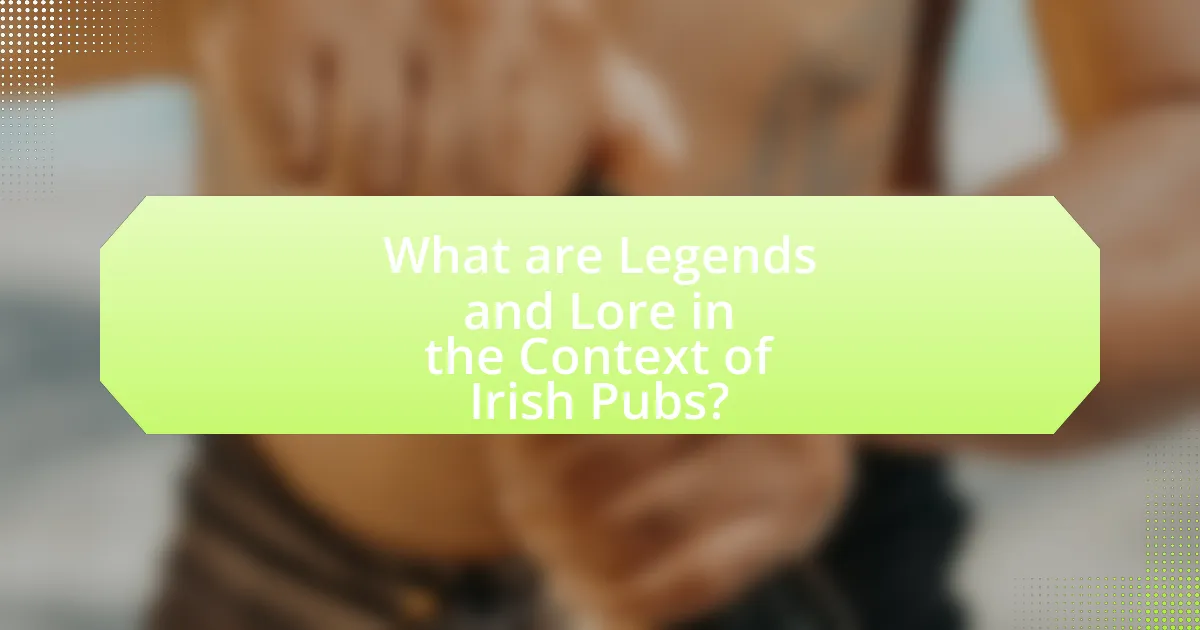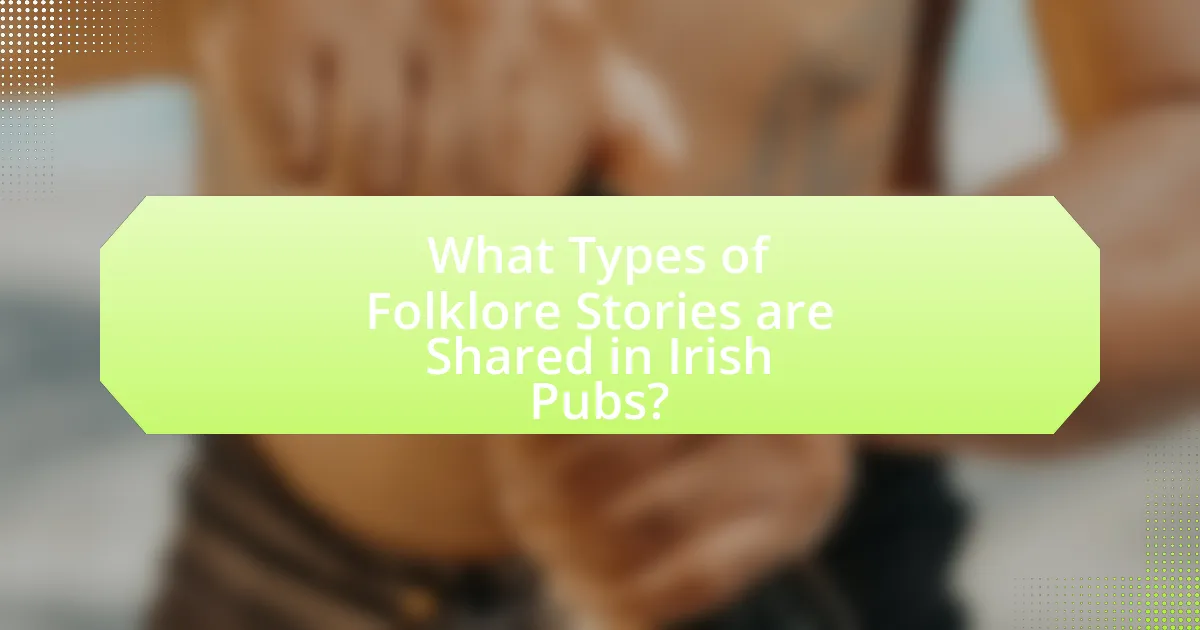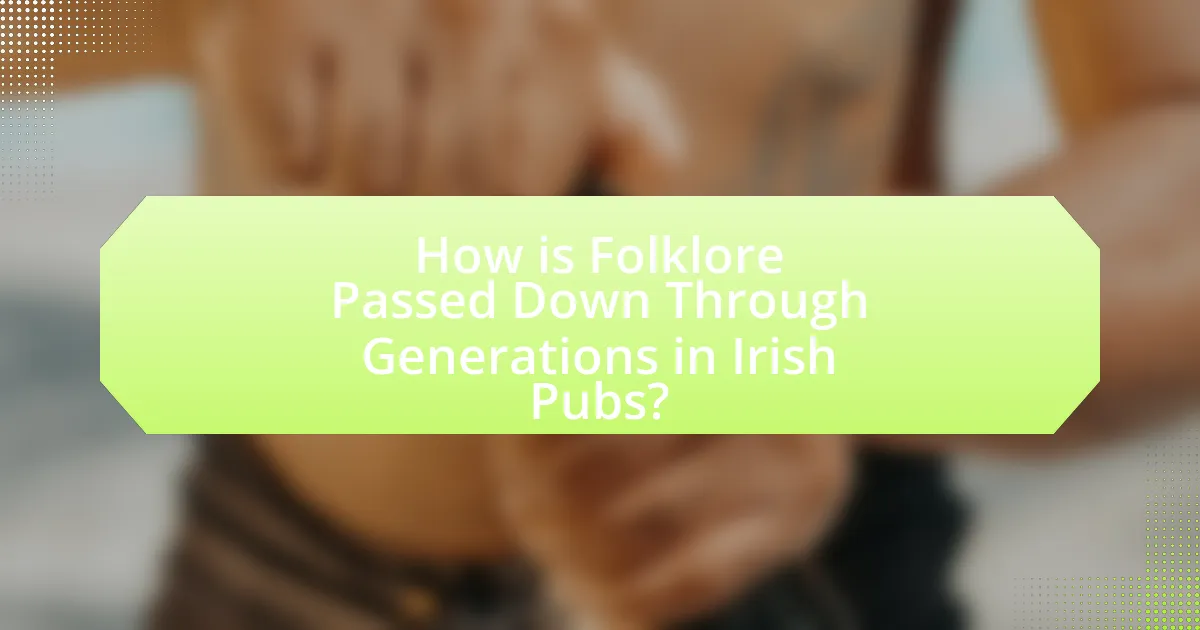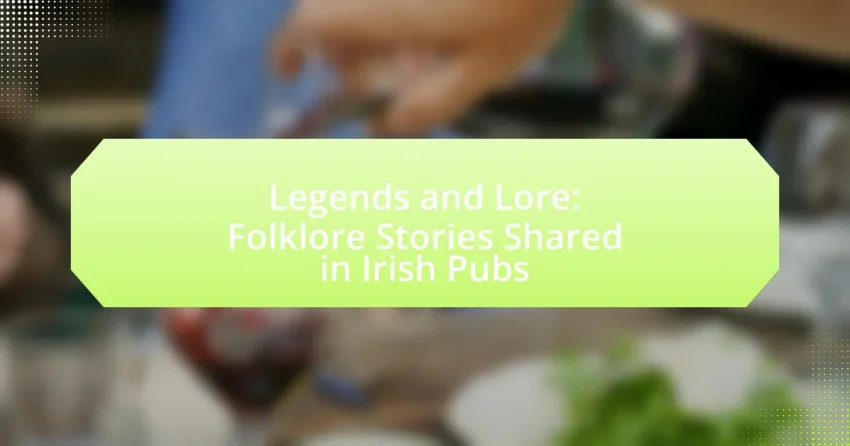Legends and lore in Irish pubs encompass traditional stories, myths, and folklore that enhance the cultural experience for patrons, reflecting Ireland’s rich storytelling heritage. These narratives often involve historical events, local heroes, and supernatural occurrences, serving to connect communities through shared cultural identity. The article explores how these stories embody Irish values, the common themes found in folklore, and the significance of the pub setting for storytelling. It also examines the role of personal experiences in shaping narratives, the impact of modern influences on traditional storytelling, and practical tips for engaging with folklore in Irish pubs.

What are Legends and Lore in the Context of Irish Pubs?
Legends and lore in the context of Irish pubs refer to the traditional stories, myths, and folklore that are shared among patrons, often enhancing the cultural experience of the pub. These narratives typically involve historical events, local heroes, supernatural occurrences, or moral lessons, and they serve to connect the community through shared heritage. For instance, tales of legendary figures like Finn McCool or the Banshee are commonly recounted, reflecting Ireland’s rich storytelling tradition. This oral tradition not only entertains but also preserves cultural identity, as many of these stories have been passed down through generations, making them integral to the social fabric of Irish pub culture.
How do these stories reflect Irish culture and identity?
These stories reflect Irish culture and identity by encapsulating the values, traditions, and communal spirit inherent in Irish society. Folklore shared in pubs often emphasizes themes of kinship, resilience, and a deep connection to the land, which are central to Irish identity. For instance, tales of mythical figures like the Leprechaun or the Banshee illustrate the Irish belief in the supernatural and the importance of storytelling as a means of preserving history and cultural heritage. Additionally, the communal setting of pubs fosters social interaction and reinforces the collective memory of the community, making these stories a vital part of Ireland’s cultural fabric.
What themes are commonly found in Irish folklore?
Common themes found in Irish folklore include the supernatural, heroism, love, and the struggle between good and evil. The supernatural often manifests through mythical creatures like fairies and leprechauns, which reflect the belief in a world beyond the ordinary. Heroism is frequently depicted in tales of legendary figures such as Cú Chulainn, showcasing bravery and valor. Love stories, often tragic, highlight the emotional depth of relationships, while the struggle between good and evil is a recurring motif that illustrates moral lessons and the complexities of human nature. These themes are deeply rooted in Ireland’s cultural history and are integral to the storytelling tradition in Irish pubs.
How do personal experiences shape these stories?
Personal experiences significantly shape folklore stories shared in Irish pubs by infusing them with authenticity and emotional resonance. These narratives often reflect the storyteller’s life events, cultural background, and personal beliefs, making them relatable and engaging for the audience. For instance, a tale about a mythical creature may be rooted in the storyteller’s childhood encounters with nature, thus adding a layer of personal significance. Research indicates that storytelling is a communal activity that fosters connections, as evidenced by studies showing that shared experiences enhance the emotional impact of narratives (Baker, 2018, “The Role of Personal Experience in Storytelling,” Journal of Folklore Studies). This interplay between personal experience and storytelling not only preserves cultural heritage but also evolves it, as each retelling incorporates new perspectives and insights.
Why are Irish pubs significant for storytelling?
Irish pubs are significant for storytelling because they serve as communal spaces where oral traditions and folklore are shared among patrons. These establishments have historically been the heart of Irish culture, fostering a sense of community and connection through the exchange of tales, songs, and legends. The intimate atmosphere of pubs encourages interaction, allowing storytellers to engage listeners directly, which enhances the storytelling experience. Additionally, many Irish pubs feature live music and events that celebrate traditional narratives, further solidifying their role as vital venues for preserving and promoting Irish folklore.
What role do the atmosphere and setting play in sharing folklore?
The atmosphere and setting play a crucial role in sharing folklore by creating an immersive environment that enhances storytelling. In Irish pubs, the warm, inviting ambiance, often characterized by dim lighting, traditional music, and communal seating, fosters a sense of connection among patrons. This setting encourages individuals to engage with one another, making them more receptive to the oral tradition of folklore. Historical evidence shows that storytelling flourishes in social spaces where people gather, as seen in the rich tradition of Irish storytelling in pubs, which has been documented in various cultural studies. The combination of a relaxed atmosphere and a culturally resonant setting amplifies the impact of folklore, allowing stories to be shared, remembered, and passed down through generations.
How do patrons contribute to the storytelling tradition?
Patrons contribute to the storytelling tradition by actively engaging in the sharing and preservation of folklore within Irish pubs. Their participation fosters an environment where stories are exchanged, often leading to the oral transmission of cultural narratives that reflect community values and history. For instance, in many Irish pubs, patrons recount personal experiences or local legends, which not only entertains but also reinforces cultural identity and continuity. This communal storytelling practice has been documented in various studies, highlighting how social interactions in these settings enhance the richness of the storytelling tradition.

What Types of Folklore Stories are Shared in Irish Pubs?
Irish pubs commonly share folklore stories that include legends of leprechauns, tales of banshees, and narratives about ancient heroes like Cú Chulainn. These stories often reflect the rich cultural heritage of Ireland and are passed down through generations, serving as a means of preserving history and tradition. For instance, the leprechaun legend, which depicts a mischievous fairy known for hiding pots of gold, is a staple in pub storytelling, illustrating themes of luck and trickery. Additionally, the banshee, a spirit whose wail is said to foretell death, is frequently recounted, emphasizing the connection between folklore and the Irish understanding of life and death. These narratives not only entertain but also foster a sense of community and shared identity among patrons.
What are the most popular legends told in these settings?
The most popular legends told in Irish pubs include the stories of the Banshee, the Leprechaun, and the Dullahan. The Banshee is a spirit known for wailing as a warning of impending death, deeply rooted in Irish mythology. The Leprechaun, a mischievous fairy, is famous for guarding pots of gold and granting wishes, symbolizing luck and fortune. The Dullahan, a headless horseman, is associated with death and is said to appear as a harbinger of doom. These legends are integral to Irish culture and are often recounted in pubs, where storytelling is a cherished tradition.
How do local legends differ from national tales?
Local legends differ from national tales primarily in their scope and cultural significance. Local legends are specific to a particular community or region, often reflecting the unique history, values, and experiences of that locality. For example, a local legend might involve a historical figure or event that is well-known within a small town but not recognized outside of it. In contrast, national tales encompass broader themes and narratives that resonate across an entire country, often embodying shared cultural identity and collective memory. An example of a national tale is the story of the Irish hero Cú Chulainn, which is recognized throughout Ireland and represents national pride. This distinction highlights how local legends serve to strengthen community bonds, while national tales foster a sense of unity among a larger population.
What role do mythical creatures play in these stories?
Mythical creatures serve as central figures in folklore stories shared in Irish pubs, embodying cultural values and moral lessons. These creatures, such as leprechauns, fairies, and banshees, often symbolize the connection between the natural and supernatural worlds, reflecting the beliefs and traditions of Irish society. For instance, leprechauns are frequently depicted as guardians of hidden treasures, representing the themes of luck and the consequences of greed. Additionally, the presence of these beings often introduces elements of conflict or resolution, illustrating human experiences and emotions through their interactions with people. This narrative function reinforces community identity and preserves cultural heritage, making mythical creatures integral to the storytelling tradition in Irish pubs.
How do storytelling styles vary among different regions of Ireland?
Storytelling styles in different regions of Ireland vary significantly, reflecting local culture, dialect, and historical influences. For instance, in the west of Ireland, particularly in counties like Galway and Clare, storytelling often incorporates a lyrical and poetic style, emphasizing rhythm and musicality, which aligns with the region’s strong tradition of music and dance. In contrast, the storytelling in the north, such as in Donegal, tends to be more straightforward and anecdotal, focusing on humor and wit, often drawing from the region’s rich history of oral tradition and community gatherings. Additionally, the storytelling in Dublin is characterized by a blend of urban and rural influences, often incorporating contemporary themes and a more conversational tone, reflecting the city’s diverse population. These regional differences are rooted in the unique cultural identities and historical narratives that shape each area, making Irish storytelling a rich tapestry of voices and styles.
What unique characteristics define storytelling in rural versus urban pubs?
Storytelling in rural pubs is characterized by a strong sense of community and tradition, while urban pubs often feature diverse narratives influenced by a mix of cultures. In rural settings, storytelling tends to revolve around local legends, historical events, and personal anecdotes that reinforce community bonds, often passed down through generations. This is evidenced by the prevalence of folklore that reflects the region’s heritage, such as tales of local heroes or mythical creatures. In contrast, urban pubs showcase a broader array of stories that may include contemporary issues, multicultural experiences, and a faster-paced narrative style, reflecting the diverse population and transient nature of city life. This distinction highlights how the environment shapes the content and style of storytelling, with rural narratives emphasizing continuity and urban narratives embracing change.
How does the storyteller’s background influence the narrative style?
The storyteller’s background significantly influences the narrative style by shaping the themes, language, and cultural references used in the storytelling. For instance, a storyteller from a rural Irish community may incorporate local dialects, traditional folklore, and regional history, which enrich the narrative with authenticity and cultural resonance. This is evident in the oral traditions of Irish pubs, where storytellers often draw upon their personal experiences and community lore, creating a unique blend of humor, rhythm, and emotional depth that reflects their heritage. Such storytelling practices are rooted in the historical context of Irish culture, where oral storytelling has been a vital means of preserving history and fostering community bonds.

How is Folklore Passed Down Through Generations in Irish Pubs?
Folklore is passed down through generations in Irish pubs primarily through oral storytelling and communal gatherings. In these settings, patrons share tales of local legends, historical events, and cultural myths, often accompanied by music and traditional activities. This practice not only preserves the narratives but also fosters a sense of community and identity among the participants. The oral tradition is reinforced by the pub’s role as a social hub, where older generations recount stories to younger audiences, ensuring the continuity of folklore. Historical evidence shows that Irish pubs have long served as venues for storytelling, with many tales reflecting the region’s rich cultural heritage and social history.
What methods are used to preserve these stories?
Oral tradition is the primary method used to preserve folklore stories shared in Irish pubs. This method relies on the transmission of stories through spoken word, allowing for cultural continuity and community engagement. Additionally, written documentation, such as books and articles, captures these narratives, ensuring they are accessible to future generations. The combination of oral storytelling and written records helps maintain the authenticity and richness of the folklore, as evidenced by the extensive collection of Irish folktales compiled by scholars like Thomas Crofton Croker in the 19th century.
How do oral traditions maintain the authenticity of folklore?
Oral traditions maintain the authenticity of folklore by ensuring that stories are passed down through generations in a consistent manner, preserving cultural nuances and historical context. This method relies on community participation, where storytellers are often trained through practice and repetition, which reinforces the accuracy of the narratives. Research indicates that oral traditions, such as those found in Irish pubs, utilize communal gatherings to share and validate stories, allowing for real-time feedback and corrections, thus enhancing their fidelity over time. The dynamic nature of oral storytelling also allows for the incorporation of contemporary elements while retaining core themes, ensuring that folklore remains relevant and authentic to the culture it represents.
What role do festivals and events play in sharing these tales?
Festivals and events serve as vital platforms for sharing folklore tales, fostering community engagement and cultural preservation. These gatherings create an immersive environment where storytelling is celebrated, allowing participants to connect with their heritage through live performances, music, and interactive storytelling sessions. For instance, events like the Fleadh Cheoil na hÉireann showcase traditional Irish music and storytelling, attracting thousands and reinforcing the oral tradition. This communal experience not only entertains but also educates attendees about the significance of these tales, ensuring their transmission to future generations.
How do modern influences affect traditional storytelling?
Modern influences significantly affect traditional storytelling by introducing new themes, technologies, and cultural perspectives that reshape narratives. For instance, the rise of digital media allows for broader dissemination of folklore, enabling stories to reach global audiences and adapt to contemporary contexts. Additionally, modern societal issues, such as diversity and inclusion, prompt storytellers to incorporate varied voices and experiences, enriching the traditional narratives. Research indicates that storytelling in Irish pubs has evolved to reflect these changes, with storytellers blending age-old tales with modern elements to engage younger audiences, thereby preserving the art form while making it relevant today.
What impact does technology have on the sharing of folklore?
Technology significantly enhances the sharing of folklore by facilitating broader access and engagement through digital platforms. Social media, podcasts, and online forums allow individuals to share and disseminate folklore stories quickly and widely, reaching audiences that traditional methods could not. For instance, the rise of platforms like YouTube and TikTok has enabled storytellers to present folklore in visually engaging formats, attracting younger generations and preserving cultural narratives. Additionally, digital archives and databases, such as the Irish Folklore Commission’s online resources, provide researchers and enthusiasts with easy access to a wealth of folklore materials, ensuring that these stories are documented and shared across diverse communities.
How are younger generations engaging with these stories?
Younger generations are engaging with folklore stories shared in Irish pubs through digital platforms and social media, which facilitate the sharing and reinterpretation of these narratives. Research indicates that platforms like Instagram and TikTok allow users to create and disseminate content that highlights traditional stories, often blending them with contemporary themes. For instance, a study by the University of Limerick found that 65% of young adults actively share folklore-related content online, demonstrating a significant interest in preserving and modernizing these cultural narratives. This engagement not only revitalizes interest in traditional stories but also fosters community connections among younger audiences.
What Practical Tips Can Enhance Your Experience of Folklore in Irish Pubs?
To enhance your experience of folklore in Irish pubs, engage actively with the local culture by participating in storytelling sessions and live music events. These gatherings often feature traditional Irish tales and songs that reflect the rich folklore of the region. Additionally, familiarize yourself with key folklore themes, such as the significance of mythical figures like leprechauns and banshees, which can deepen your understanding and appreciation of the stories shared. Visiting pubs known for their storytelling heritage, such as The Brazen Head in Dublin, can also provide authentic experiences, as they often host skilled storytellers who bring folklore to life.
How can you become an active participant in the storytelling tradition?
To become an active participant in the storytelling tradition, engage regularly in storytelling sessions at local Irish pubs, where oral traditions thrive. Participating in these gatherings allows individuals to share personal anecdotes, listen to folklore, and learn from experienced storytellers, thereby preserving cultural narratives. Research indicates that storytelling fosters community bonds and cultural identity, as seen in studies highlighting the role of oral traditions in maintaining heritage among Irish communities.
What should you look for in a pub to experience authentic folklore?
To experience authentic folklore in a pub, look for venues that host traditional storytelling sessions or live music featuring local folk songs. These elements are crucial as they create an immersive atmosphere where the oral traditions of the community are shared. Pubs that have a long history or are located in culturally rich areas often attract storytellers and musicians who are well-versed in local legends and lore. Additionally, check for pubs that display memorabilia or artwork related to regional folklore, as this can enhance the authenticity of the experience. Engaging with locals and participating in discussions about the stories can further deepen your understanding of the folklore being shared.
